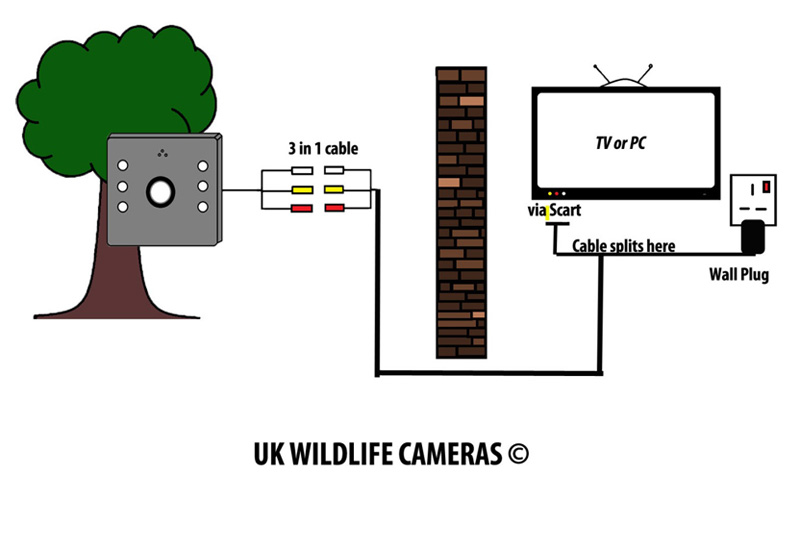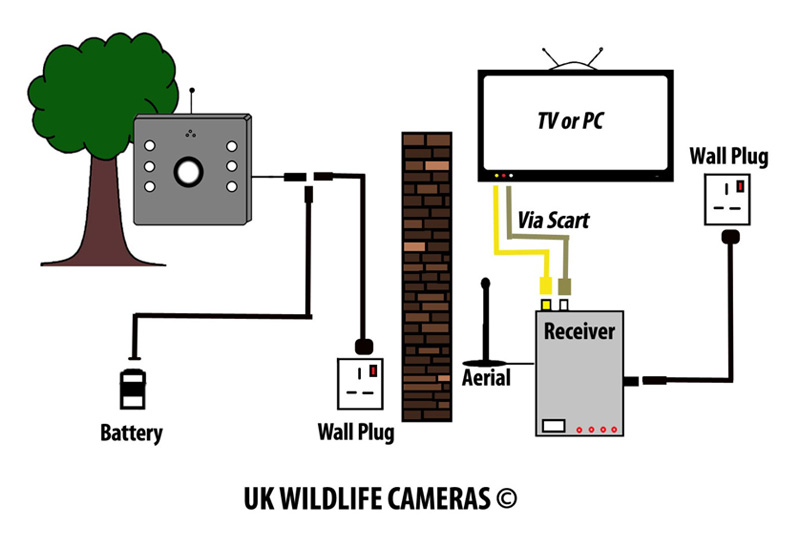We use cookies to make your experience better. To comply with the new e-Privacy directive, we need to ask for your consent to set the cookies. Learn more.
Cameras - Which Wildlife System is Best for Me ?
On this page we will explain & give guidance on the camera systems we sell. We hope you will find it useful. Should there be any questions or require any additional help do let us know via our contact page.
"Wired or Wireless Wildlife Camera System ?"- Can be found at the bottom of the page
Resolution
The resolution of a digital camera is expressed in megapixels. The more pixels a camera can capture, the more detailed the image. Because wildlife cameras and CCTV equipment are video systems, resolution is measured in TV Lines (TVL). This is an analog measure of the number of lines viewable on a monitor screen, also known as Lines of Horizontal Resolution (LoHR). The higher the number, the better the picture renders on a monitor.
Image sensors
A camera sensor is like a small chip that captures the light coming in through the lens to form an image. It is made up of millions of light-sensitive spots called photo-sites that capture the light information seen through the lens. The device then converts the image into electronic signals.
Types of sensors
There are two types of sensor: CCD (charge-coupled device) and CMOS (complementary metal-oxide semiconductor). Traditionally, more sensitive CCD’s were considered superior to CMOS sensors. The main limitation of a CCD sensor is that it’s susceptible to blooming and smear when overloaded by bright light.
Nowadays, CMOS technology has the same sensitivity without image distortion problems. CMOS sensors also consume less power, allow cameras to be smaller, and are cheaper to produce.
Sensor size
Have you ever wondered why smartphone cameras boast high megapixels, but photo quality isn’t brilliant, especially in low light? It’s because they tend to have tiny camera sensors. Smaller sensors take in less light through the lens and are more likely to suffer image deterioration or noise.
A bigger sensor takes in more light. Therefore it takes more detailed images and better pictures in low light conditions.
A camera’s sensor size is normally expressed in old-fashioned imperial fractions of an inch. Some manufacturers give the size in millimetres, so it can get confusing. As an example, 1/3 inch sensor is larger than 1/4 inch sensor.
- 1/4" sensors measure 7.68mm² (3.2mm by 2.4mm).
- 1/3" sensors measure 17.28mm² (4.8mm by 3.6mm).
Lens size
Field of view (FOV) is the area the camera can see, measured in degrees. A larger field of view means a camera can see a wider area, but with a loss of fine detail. It is determined by the size of the camera lens, or focal length.
Cameras with a smaller lens (wide-angle lens), produce a greater FOV than cameras with a larger lens. The smaller lens camera sees a large area, but objects will appear smaller (more distant) within the scene area. The reverse is true for larger lens cameras, the view is narrower but objects are closer.
- 2.1mm lens has approx. 158° FOV
- 3.6mm lens has approx. 92° FOV
Night vision
Wildlife cameras can operate in complete darkness with infra-red (IR) lighting. LED illuminators provide light so the camera can operate. The light is almost invisible to the naked eye, so it doesn’t scare animals. In IR-mode, output switches to black and white. The quality of the picture depends on the amount of light provided. For example, our bird box cameras have 6 LED’s, 3 at each side of the lens, which will provide enough lighting for up to 2m.
Lux
Lux is a measure of light intensity. Bright sunlight is around 100,000 Lux, complete darkness is 0. It is often used in camera specification. E.g. a 0 Lux camera is a true night-vision camera as it can see with zero light using nightvision leds.
Wired camera systems
With a wired set-up, a cable sends the video and audio signals. A 3-in-1 cable connects the camera to TV AV sockets (or scart adapter) and mains power. Drilling of holes may be required to pass it through walls. This isn’t always necessary because at 2mm thick, it is small enough slip through a window seal.
Wireless camera systems
Video and audio is wirelessly transmitted to a small antenna. A multi-channel receiver picks up the information which is connected to a TV or PC for viewing. The camera can run-off a battery or through an outdoor power supply.
Wired vs. wireless
Both systems have a fairly straight-forward set-up. Neither require tuning-in, you just select the right channel. The disadvantage with a wired system is the hassle. You’ll have to trail cables from the camera’s location to your TV which may involve drilling through walls. But, if you’ve no power outside, and don’t want the inconvenience of using batteries, you’ll have to this with a wireless camera also
Wireless cameras are more expensive (£49.99 vs. £82.99 for a bird box camera kit). However, they have another great advantage. The multi-channel receiver means you can easily expand, adding up to 3 more cameras, without wires.
Both of our wired & wireless camera kits are very straightfoward to set up as illustrated below.
Wired Camera Setup

Wireless Camera Setup

If cabling from the camera all the way to the TV is a problem , then the wireless camera kit is best suited for you. The wireless camera will transmit video & audio wirelessly , however it will need to be powered by a power source. This can either be using the mains power supply unit provided in the kit or using a battery. The mains power supply unit can be plugged to a nearby socket eg shed or a garrage without the need of wiring all the way back to the house.
Quality of the video produced by both systems can be the same. A wireless camera has simply a transmitter connected to the video & audio leads inside unit.
Pros & Cons of a Wireless Camera Kit
- Easy to setup.
- Can easily add 3 additional cameras to the system without the need of purchasing additional receivers.
- Up to 100m unobstracted range. Some models may be less or more.
- No hasstle with the audio & video cable as there isn't one.
- Wireless range will be reduced by walls, ceilings etc.
- There may be wireless intereferences from other devices.
Pros & Cons of a Wired Camera Kit
- Easy to setup. Probably even easier than setting up a wireless camera kit as there are only three main components (Camera, Cable, Power Supply).
- Range of up to suggested 100m with our kits and the 3 in 1 cable can be easily extended by simply adding another length.
- Cable can slip through the window seal without the need of drilling through walls.
- Interference may still occur from other electical devices.
- The 3 in 1 cable will need to be clipped/burried, secured to the surroundings.
- Drilling through walls maybe neccessary.
